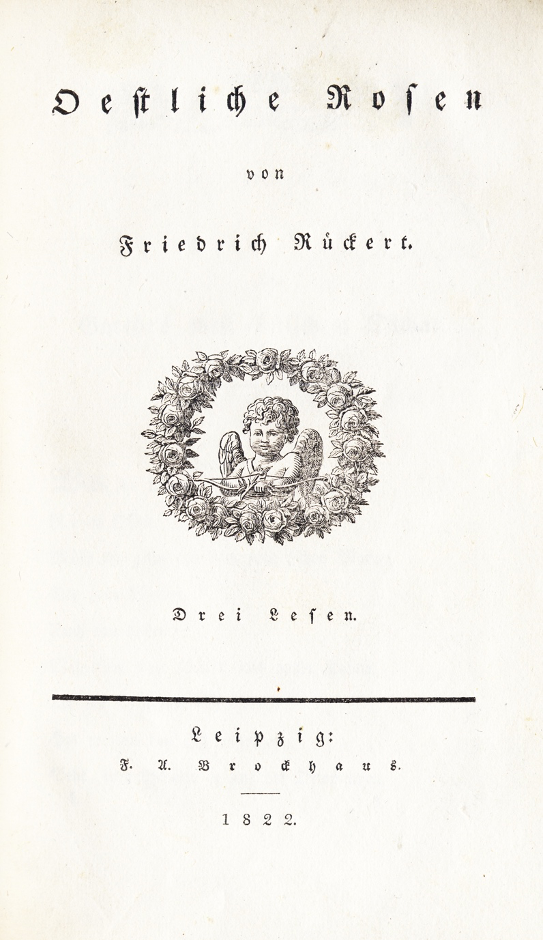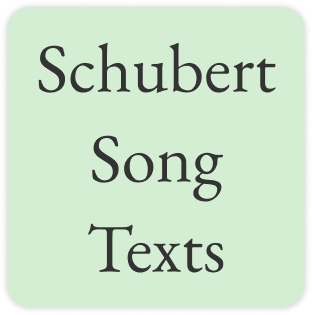Let me greet you
(Poet's title: Sei mir gegrüßt)
Set by Schubert:
D 741
[late 1821]
O du Entrissne mir und meinem Kusse;
Sei mir gegrüßt,
Sei mir geküßt.
Erreichbar nur meinem Sehnsuchtsgruße;
Sei mir gegrüßt,
Sei mir geküßt.
Du von der Hand der Liebe diesem Herzen
Gegebne, du
Von dieser Brust
Genommne mir! mit diesem Tränengusse
Sei mir gegrüßt,
Sei mir geküßt.
Zum Trotz der Ferne, die sich feindlich trennend
Hat zwischen mich
Und dich gestellt,
Dem Neid der Schicksalsmächte zum Verdrusse
Sei mir gegrüßt,
Sei mir geküßt.
Wie du mir je im schönsten Lenz der Liebe
Mit Gruß und Kuss
Entgegen kamst,
Mit meiner Seele glühendstem Ergusse,
Sei mir gegrüßt,
Sei mir geküßt.
Ein Hauch der Liebe tilget Räum’ und Zeiten,
Ich bin bei dir,
Du bist bei mir,
Ich halte dich in dieses Arms Umschlusse,
Sei mir gegrüßt,
Sei mir geküßt!
Oh, you who have been snatched away from me and my kisses!
Let me greet you!
Let me kiss you!
Reachable only by the greetings that come from my longing!
Let me greet you!
Let me kiss you!
You whom the hand of love offered to this heart
As a gift! you
Left this breast,
Taken away from me! With this outpouring of tears
Let me greet you!
Let me kiss you!
In defiance of the distance inimically separating us,
Between me
And you set up as a barrier;
In order to spite the envy of the powers of fate
Let me greet you!
Let me kiss you!
Just as you came to me in the most beautiful springtime of love
With a greeting and a kiss
As you approached me,
With the most glowing emission of my soul
Let me greet you!
Let me kiss you!
A breath of love erases space and time,
I am alongside you,
You are alongside me,
I hold you in this embrace of my arms,
Let me greet you!
Let me kiss you!
All translations into English that appear on this website, unless otherwise stated, are by Malcolm Wren. You are free to use them on condition that you acknowledge Malcolm Wren as the translator and schubertsong.uk as the source. Unless otherwise stated, the comments and essays that appear after the texts and translations are by Malcolm Wren and are © Copyright.
☙
Themes and images in this text:
Arms and embracing Breath and breathing Chest / breast Fate, luck and lotteries Greetings Hands Hearts Kissing Longing and yearning Near and far Soul Space Spring (season) Tears and crying Time
GHAZAL A monorhymed lyric poem . . . common to Arabic, Persian, Turkish, Uzbek, Pashto, and Urdu literature. The rhyme scheme is aa ba ca, etc., and, after the 12th century, the poet mentions his name toward the end of the poem. Classical ghazals share a limited range of images and a fairly restricted vocabulary. The principal subject of the ghazal is earthly or mystical love, and the mood is melancholy, expressing sadness over separation from the beloved. The ghazal took its canonical form in Persian in the 11th - 12th centuries. The most famous of all ghazal poets were the Persians Sa'di (d. 1292), Hafez (d. 1389-90), and Sa'eb (d. 1677-78); and the genre developed in other literatures under strong Persian influence. . . . Translations of Hafez inspired the German romantic poets, especially Goethe, whose West-östliche Divan imitated Persian models. Platen wrote a large number of ghazals. . . . William L. Hanaway, in The New Princeton Encyclopedia of Poetry and Poetics Princeton University Press 1993 pp. 478-9
Friedrich Rückert learned the ghazal form (and the Farsi language itself) in Vienna in 1818 and 1819 from Joseph von Hammer-Purgstall, whose translations of Hafez (Diwan des Hafis, 1812) inspired Goethe’s West-östliche Divan (published 1819). ‘Sei mir gegrüßt’ was first published in Leipzig in 1822 in Oestliche Rosen von Friedrich Rückert. Like all the poems in the ‘Eastern Roses’ collection, this ghazal had no title.

It may be that the presence of the cupid on the title page of this collection misled some of the first readers, who saw the text primarily as a love poem, overlooking the funereal wreath of roses which is equally prominent. In fact there are enough indications in the text of ‘Sei mir gegrüßt’ that the poetic persona is writing about someone he has lost for us to conclude that the primary tone is elegiac rather than amorous. She has been snatched away, she can only be reached by means of yearning, he is in tears after she is plucked from his breast, they have to defy distance and fate to remain in contact, he can only hold her in his embrace if time and space are erased. Above all, the repeated subjunctives ‘sei mir gegrüßt, sei mir geküßt!’ (‘if only I were able to greet and kiss you’ might be one way of translating this) remind us that the speaker is not describing reality, is not performing an action in the world as it is. He is imagining and attempting to invoke a world in which it might be possible to greet and to kiss the beloved, but he clearly knows very well that it cannot be.
☙
Original Spelling Sei mir gegrüßt O du Entriss'ne mir und meinem Kusse! Sey mir gegrüßt! Sey mir geküßt! Erreichbar nur meinem Sehnsuchtsgruße! Sey mir gegrüßt! Sey mir geküßt! Du von der Hand der Liebe diesem Herzen Gegeb'ne! du Von dieser Brust Genomm'ne mir! mit diesem Thränengusse Sey mir gegrüßt! Sey mir geküßt! Zum Trotz der Ferne, die sich, feindlich trennend, Hat zwischen mich Und dich gestellt; Dem Neid der Schicksalsmächte zum Verdrusse Sey mir gegrüßt! Sey mir geküßt! Wie du mir je im schönsten Lenz der Liebe Mit Gruß und Kuß Entgegen kamst, Mit meiner Seele glühendstem Ergusse Sey mir gegrüßt! Sey mir geküßt! Ein Hauch der Liebe tilget Räum' und Zeiten, Ich bin bei dir, Du bist bei mir, Ich halte dich in dieses Arms Umschlusse, Sey mir gegrüßt! Sey mir geküßt!
Confirmed by Peter Rastl with Schubert’s source, Oestliche Rosen von Friedrich Rückert. Drei Lesen. Leipzig: F. A. Brockhaus. 1822, pages 320-321; and with Gesammelte Gedichte von Friedrich Rückert. Vierter Band. Erlangen, Verlag von Carl Heyder. 1837, page 187.
Note: The poem was first published 1822 in Rückert’s Oestliche Rosen where all the poems have no titles. In subsequent editions (Erlangen, 1837: Gesammelte Gedichte, Frankfurt a. M., 1868: Gesammelte Poetische Werke) this poem got the title Sei mir gegrüßt! and is printed in a different format: each three lines of the original poem was combined into one single line.
To see an early edition of the text, go to page 320 [Erstes Bild 328] here: https://download.digitale-sammlungen.de/BOOKS/download.pl?id=bsb10117423


